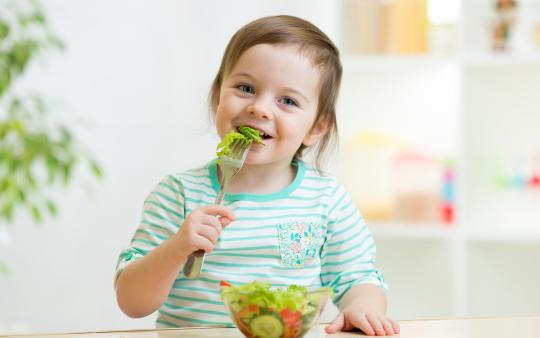Did I actually let my child have gummy bears for lunch, you ask? It’s not uncommon for parents to start out with the best of intentions when it comes to their child’s food choices, thoughtfully selecting the highest quality organic produce and swearing off anything deemed to be even remotely “unhealthy”. It’s almost impossible to avoid the bright colors, clever marketing, and addictively delicious flavours of sugar, salt, and saturated fat, but somehow even the most conscientious of parents can end up in a relentless negotiation over, and worn-out surrender to, junk food—especially in those inevitable moments when convenience is king. But with patience, consistency, and a healthy dose of fun, there are many strategies for junking the junk food that don’t immediately result in melt-downs and tantrums.
1. Recalibrate their taste buds
Hide those veggies
While sneaking in veggies is a great way to boost nutrition, it shouldn’t be the only way your child gets their greens. Visually being able to see and know the vegetables they are consuming is good, not only for their developing palates but also to help foster a mindful approach to eating. However, sometimes changed eating habits or newly adopted picky lifestyles may mean getting creative to help those taste buds get back in line! Try pureeing veggies like spinach, kale, squash, and beets. You can add them to your favourite muffin or pancake batter or beef up dinnertime soups and sauces. You can even start the day off right by blending greens into breakfast smoothies. Whether you tell your kids about the sneaky veggies or not, getting those taste buds recalibrated to the flavour profile of vegetables gets you going in the right direction!
2. Reposition the status of veggies
Make it fun
Cookie cutters can be a parent’s best friend and secret weapon when it comes to serving up enticing tidbits. Who wouldn’t love star-shaped radishes, zucchini hearts, or roasted sweet potato in the shape of a dinosaur? Engaging your child’s imagination with fun shapes can reposition vegetables as enjoyable and entertaining rather than defaulting to dislike.
3. Channel the need for control
Get your child in the kitchen
It is a normal part of child development for kids to try to exert some control over their environment. Channeling this desire for autonomy can work in your favour in the kitchen! When kids participate in meal planning, grocery shopping, harvesting the garden, and cooking a meal they are invested in what ends up on the table and are much more likely to partake. It also helps kids explore different flavours and food preparations to find what they enjoy—it might even be a little weird but roll with it if it’s healthy! Being a part of the process normalizes the inclusion of vegetables and demystifies the food group. And it never hurts to have an extra sous chef!
4. Find a balance
Mix it up!
When you want your child to eat a new healthy food it can be helpful to introduce it surrounded by or mixed in with foods your child already loves. Psychologically, your child is more likely to accept a new food when they are already eating food they prefer. If they only nibble or even reject the new food outright, that’s ok! Keep offering it—you might just catch them on a good day! Increasing exposure to healthy food, even if it isn’t eaten, normalizes these foods and helps solidify expectations.
5. Be prepared
Stock the pantry
It’s easy to get tripped up and resort to junk food when schedules get busy and convenience is a priority. Anticipating these moments (you know they’ll happen!) will ensure healthy food is at-the-ready and junk food habits aren’t rekindled. Meal planning, having simple go-to meals identified, making sure your pantry is filled with good food choices, and your fridge filled with on-the-go snacks you’ve already prepared minimizes the allure of junk food as an option.
6. Compromise
DIY the junk food
Part of what makes junk food junky is all the unpronounceable ingredients and excessive amounts of processed sugar, salt, and fat, which in some foods are at the top of the ingredient list! A great way to offer a favourite treat while weaning off the junk food and maintaining your healthy eating goals is to recreate a recipe at home. The internet is full of homemade “copycat” versions of popular brand cookies, crackers, and bars. Sweeten with bananas or apple sauce. Make snacks more savoury with nutritional yeast. Cook with healthy fats and oils. Making these foods at home keeps those offending ingredients to a minimum and limits the amount that can be consumed. If the only opportunity to eat junk foods requires the effort and time to make them from scratch, your kids are less likely to have unfettered access to them.
7. Set a good example
Practice what you preach
Kids will absolutely notice if your food choices are not in line with what you are expecting them to eat. The best way to get your kids to eat healthy foods is to model eating healthy foods. This may entail a deep dive into habits of emotional eating. When you set a good eating example, the temptation to cite your hypocrisy as justification (“It’s not fair!”) and the inevitable ensuing battle it will provoke is removed.
8. Find a new reward
Skip the bribery
It can be really tempting to use treats and favorite junk foods to grease the wheels in tough parenting situations. Disassociating food and positive behaviour--reward eating--can reduce food battles in the short term and sets the stage for a mindful relationship with food in the long term. Finding non-food alternatives will better serve your big picture goals for diet but you can go even further by refraining from motivating good behaviour with external rewards, and instead learn how to help kids behave better based on their innate empathy.
9. Natural energy
Get those ZZZZs
Making sure your child is getting enough sleep is important on many levels. A well-rested child is less likely to crave the quick, easy energy found in junk food and ensures they aren’t reacting to the healthy foods you offer through an irritable and over-tired lens. Going to bed at a reasonable time at night also minimizes those late-night snacks that are almost certainly never broccoli. Also ensure that the breakfast routine and morning meals are designed to optimize mood and reduce sugar highs and crashes.
Research shows the best practice for creating sustainable habit change is consistency. No matter your strategy, your best bet is to stick to it and be just as tenacious as that piece of chewed up gum your kid got stuck in their hair! New or previously rejected foods combined with time have a way of shifting the short memories of kids. And remember: kicking junk food to the curb is a marathon, not a sprint. Happy chopping, blending, and sautéing!






